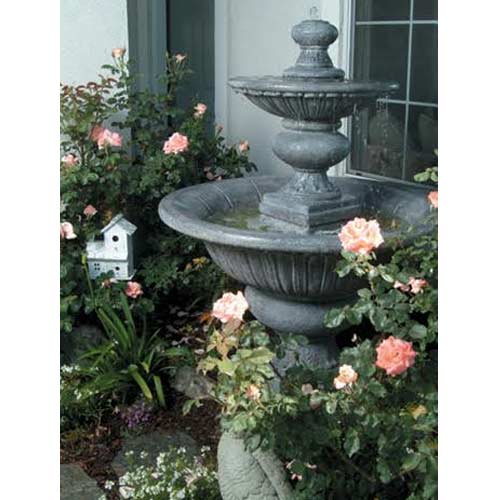Adding water features like outdoor garden fountains can transform any garden space into a peaceful retreat. To choose the best outdoor fountain for your garden, choose a design that complements your overall garden style. Many options fit different tastes and settings, whether you prefer a modern aesthetic or a more traditional look.

Consider the materials and colors that will improve your landscape. For example, a sleek, minimalistic fountain might suit a contemporary setting, while a rustic stone fountain could blend seamlessly with a natural garden design. You can explore different styles of outdoor fountains to find one that best fits your space.
Before making a decision, think about the size and scale of the fountain that would suit your garden. A large fountain may be a dramatic focal point, while a smaller one might add subtle charm. Carefully select a fountain that matches the size of your outdoor area and suits your style and budget.
Determining the Right Fountain for Your Garden
Choosing the best outdoor fountain involves considering several factors like the available space, the garden style, the material of the fountain, its size, and how well it fits with the garden’s existing decor. These key aspects help in selecting a fountain that complements your outdoor area beautifully.
Assessing Outdoor Space and Garden Style
First, consider the size and layout of your outdoor space. A spacious garden might accommodate a large, freestanding fountain, while a smaller yard could be better suited for a wall-mounted or tabletop option. Consider the current garden style—modern gardens may pair well with sleek metal designs, whereas a classic garden could benefit from a stone fountain.
Your garden’s existing landscape shapes your choice. Guarantee the fountain does not overwhelm or underwhelm the space. A landscape designer could help align the style with your vision, selecting from many fountains.
Selecting the Appropriate Material
The material of your fountain affects its durability, maintenance needs, and appearance. Natural stone options offer a timeless look but can be heavy and may require more care. Polystone or polyresin fountains provide a lighter alternative with varied design options and less upkeep.
Metal fountains like copper or stainless steel can stand out for a more contemporary appearance. Remember to choose materials suited for your climate, as temperature changes and weather conditions can impact the fountain’s longevity.
Considering Fountain Size and Water Capacity
The size of your garden fountain should be in harmony with the scale of your yard. A larger fountain can be a focal point, drawing attention, while a smaller one might add subtle charm. Consider the height, width, and depth relative to surrounding elements.
Water capacity is another important factor. A more prominent fountain may hold more water, requiring less frequent refilling. However, it could also increase water use. A balance between size and water efficiency will fit your outdoor space effectively. Guarantee the available resources can sustain the water capacity you select.
Evaluating Fountain Designs for Garden Harmony
The design of your fountain should fit seamlessly with the existing garden landscape. Evaluate how the fountain’s style, color, and texture relate to your garden environment. Stone fountains often blend well with natural surroundings, while modern designs might contrast beautifully.
Harmony between the fountain and other garden elements improves the overall aesthetic appeal. Remember how the fountain style connects visually and functionally with plants, pathways, and seating areas. Match styles to existing garden themes for a cohesive look that improves your outdoor retreat.
Installation, Maintenance, and Enhancement Features
Choosing the right outdoor fountain involves understanding the installation options, year-round maintenance tips, and ways to improve its features. Whether you have a traditional garden or a modern patio, these details will guarantee your fountain operates smoothly and adds beauty to your space.
Installation Process and Power Source Options
When installing a garden fountain, the process can vary based on size and type. Small fountains often need simple assembly, while larger ones may require professional installation for stability. It’s important to consider the power source for your fountain.
Electric fountains need an outdoor electrical outlet nearby, while solar-powered fountains use solar panels for energy. These can include a battery storage system, allowing them to operate at night or on cloudy days. Decide which power source suits your garden’s needs and accessibility.
Maintaining Your Fountain Year-Round
Proper maintenance keeps your fountain looking and functioning well. Regular cleaning is necessary to prevent algae buildup and guarantee clear water. You might use water treatments or algaecides to manage water quality. Seasonal maintenance varies according to climate.
In colder months, protect your fountain by draining and covering it if necessary, especially for materials that may crack in freezing temperatures. Look for rust-resistant components to extend the lifespan of your fountain. This planning helps avoid costly repairs and guarantees continued enjoyment.
Incorporating Lighting and Sound Elements
Adding features like lighting and sound can elevate your fountain’s ambiance. LED lights create visual interest, offering options from soft white to colorful displays. Consider LED lighting kits that can be easily added to existing fountains to illuminate your nighttime space.
The sound of water greatly influences the fountain’s atmosphere. Adjust the water flow to achieve the desired sound, improving relaxation and tranquility. Combining these features beautifies the fountain and creates a welcoming environment in your garden.
Conclusion
Choosing the right outdoor fountain for your garden involves thinking about several key points. Consider the style and purpose of your garden to find a fountain that matches the overall design and feel.
Consider the materials of the fountain. Materials like stone or metal might offer different levels of durability and aesthetic appeal.
Maintenance is another important factor. Some fountains may need more cleaning and upkeep than others. This can depend on the features and the environment in which they are placed.
Making a thoughtful choice will add beauty to your garden and create a calm and pleasant atmosphere for you to enjoy.


